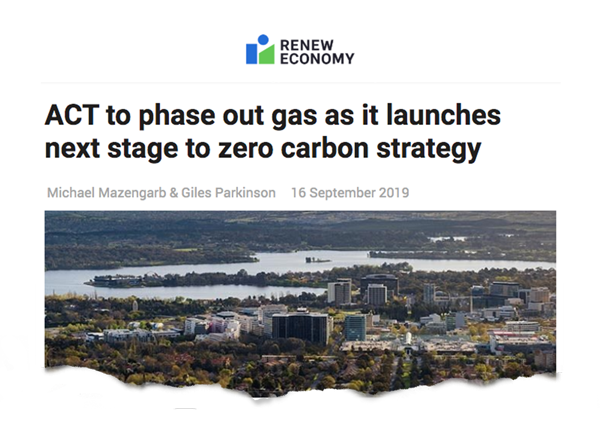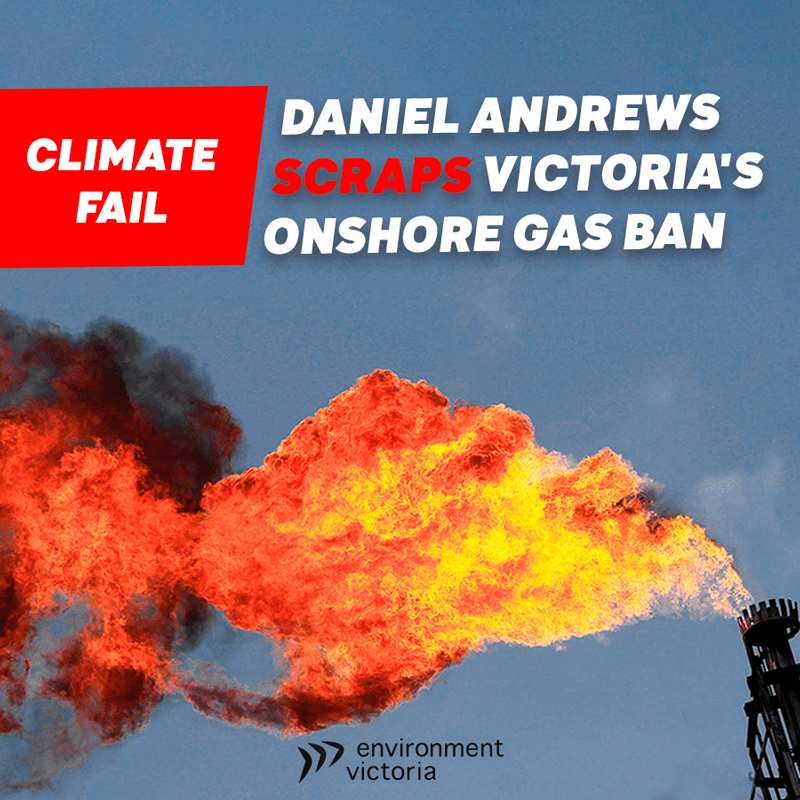Tuesday’s shock announcement that Victoria would lift the moratorium on onshore conventional gas was a massive climate fail for the Andrews government. Gas is a dirty, expensive and polluting fuel, and a dangerous distraction from the transition to renewable energy.
Victoria needs a plan to get off gas and support households and businesses to upgrade to efficient new technologies. Instead, the Andrews government has just wasted $40 million of public money searching for more gas so big energy companies can continue gouging us.
Despite increased uptake of renewable energy, Australia’s greenhouse pollution has risen in recent years. That’s largely down to one thing – the Australian gas cartel greedily sucking methane out of our farmland, bushland and ocean floors.
Until now, this was mainly a problem in the northern states. After a massive community campaign led by Lock the Gate and Friends of the Earth, the Napthine Liberal government placed a moratorium on onshore gas exploration in Victoria in 2014. Victoria’s ban held solid until this Tuesday, when Premier Andrews announced he would once again fire up the drilling rigs.
There were two parts to the announcement. The government will keep the ban on unconventional gas like fracking and coal seam gas exploration, enshrining it in the state’s constitution. This is excellent news for the environment and for regional communities concerned about damage to their land and water. But the government also announced they will allow onshore conventional gas exploration from 1 July 2021, and that’s bad news for our climate.
GAS IS A DIRTY FUEL
Gas is a dirty fossil fuel that contributes to climate change. But in making the announcement the government trotted out a decades-old myth – that gas can be a ‘transition fuel’ in the shift to cleaner energy.
The myth comes from the late 1990s, way before the current era of cheap renewable energy. The industry used to argue that gas was less polluting than coal, but it’s a false comparison. Now we have large-scale wind, solar and batteries, we can leapfrog straight to these zero-emissions technologies and avoid dirty and expensive fossil fuels altogether. [1]

The ACT has already begun phasing out gas.
Also, most gas in Victoria is actually used in homes: heating our houses and providing hot water – these two things account for almost half of the Victoria’s gas consumption. And we have solutions there too: we can use electric reverse cycle air conditioners to heat our homes, replacing gas heaters at a fraction of the running cost, and hot water heat pumps are a straight-forward alternative to gas hot water.
This is the gas plan Victoria really needs – not a plan to drill more gas, but a plan to wean ourselves off it altogether.
GAS WILL REMAIN EXPENSIVE
As anyone who has opened a gas bill lately will tell you, gas isn’t cheap – and it’s not going to get cheaper either.
Since Australia started exporting gas through massive LNG terminals in Queensland, our prices have been pegged to the more expensive international market. Opening up more gas fields in Victoria won’t change that fact.
Meanwhile, efficient reverse-cycle air conditioners, heat pumps and induction cooktops have the potential to make household gas obsolete. Research by Renew and Energy Consumers Australia estimates a large home in Melbourne would save $10,000 over a decade by going all electric. [2]
THE GOVERNMENT HAS HOOKED HOUSEHOLDS ON GAS
Despite gas being neither clean nor cheap, Victorians use more gas per person than any other state.
It isn’t just because we have a colder climate. It’s also because successive Victorian governments have hooked Victorian homes on gas through a decade of programs and regulations that have acted as a subsidy for the gas industry.
Some of these programs might have had the right intentions. Between 2011 and 2017, for example, the Victorian Government spent about $100 million on the Energy for the Regions program, which expanded the gas distribution network into rural Victoria. [3]
Investing in infrastructure for regional towns is good thing, and at the time gas may have been a cheaper option. Looking back, however, these households would have been better served by being supported to shift to all-electric appliances. Government policies have locked them into using what we now know is a polluting and increasingly expensive fuel.
The government still subsidises gas under various rebate schemes and effectively forces new homes to connect to the gas network, even when it’s not needed. For example, for solar heating to be compliant with energy efficiency requirements it must be boosted by gas, if a gas connection is available. There is no clear reason why solar water heating cannot be boosted electrically. [4]
MISUNDERSTANDING TRANSITION
At the press conference announcing that the ban would be lifted, Resources Minister Jacyln Symes misrepresented Environment Victoria’s position. She said we suggested that “we need another 10 years of gas supply”.
What we have said is that we need a plan to get off gas by 2030. That is not the same as saying we need new gas fields. We should be switching away from gas quickly enough that we don’t need new gas supplies.
Households have a simple path to electrification. Research from Beyond Zero Emissions shows how many industrial processes that currently use gas to generate heat can now be electrified or replaced with hydrogen (ideally produced using renewable energy). [5]
Reducing gas demand from households and industrial processes that need heat can take pressure off industries that use gas as a feedstock to make fertilisers, ammonia or plastics (which involves a chemical reaction of the methane in gas), or that need very high industrial heat.
Environment Victoria’s position is that we should focus on reducing household gas demand as quickly as possible. We have commissioned research, to be released shortly, showing how demand side measures can avoid any forecast shortfall in gas supply.
These household improvements include:
- Replacing ducted gas heating systems in residential buildings
- Improving insulation
- Replacing gas hot water systems with heat pumps
- Adopting heat pump space heating in commercial and residential buildings.
If the government rolls out a plan to get off gas, we won’t need new supply over the next 10 years. [6]
Replacing all those gas heaters and hot water systems takes time (and creates jobs!), and it won’t happen quickly enough without government incentives. That’s why this week’s announcement allowing more gas exploration is so misguided. It sends a message to the market and households that the government wants to head in entirely the wrong direction – towards an expensive, wasteful dead end.
None of these are new technologies or radical ideas, but the Andrews government has so far ignored calls to reduce gas demand. There is talk of a “gas strategy” being developed, but we are yet to see any details, nor are we convinced this strategy is even trying to tackle the problem at the rate needed. At the same time, they are about to consider the environmental merits of AGL’s proposed massive gas import terminal at Westernport, which would further hook Victoria on gas.
GAS IS A CLIMATE DISASTER
Gas is terrible for the environment because it pollutes in two different ways. Burning gas creates carbon dioxide emissions. But gas is mostly composed of methane, which has 86 times the global warming effect of carbon dioxide over a 20 year period, [7] and this is leaked in the process of exploration, extraction, transport and distribution.
A recent paper in the scientific journal Nature found methane released from fossil fuels is significantly underreported. [8] If more than 2% or 3% of the methane leaks, gas can be worse for the climate than coal. [9]
When developers invest in new energy projects, they expect these projects to be around for several decades at least. Encouraging new gas wells would lock in this polluting fuel. New gas developments are incompatible with serious efforts to give us a good chance of limiting warming to 1.5 degrees.
More gas means more pollution heating up our climate, which ultimately means more bushfires, droughts and heatwaves. That’s why Environment Victoria is utterly opposed to this decision and calls on the Andrews government to come up with a plan to get the state off gas as soon as possible.
THE PREMIER’S CLIMATE TEST
Premier Andrews is proud of his climate policies and frequently says “when it comes to climate change, actions speak louder than words.” He’s right, and on Tuesday his actions just set us all back.
But there is another opportunity coming to put Victoria on the right path. In the next two weeks the Premier will decide on targets to reduce emissions across the whole Victorian economy between now and 2030.
If he lives up to his words those targets will be consistent with the Paris Agreement objective of limiting global warming to 1.5 degrees. Firing up the drilling rigs just made that harder – other industries and ultimately households will have to pick up the slack while the gas cartel keeps polluting. Let’s hope that Andrews has a plan for that.
